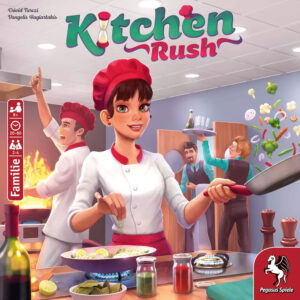 Since the beginning of my tenure here at Board Game Quest, I’ve had numerous conversations with our beloved publisher about converting the site into a full-blown foodie endeavor. Recipes, restaurant reviews, and musings about the difference between paprika and smoked paprika. (Hint: one is smoked.)
Since the beginning of my tenure here at Board Game Quest, I’ve had numerous conversations with our beloved publisher about converting the site into a full-blown foodie endeavor. Recipes, restaurant reviews, and musings about the difference between paprika and smoked paprika. (Hint: one is smoked.)
To date, these conversations haven’t gone anywhere but they did make me the obvious choice to review the revised edition of Vangelis Bagiartakis and David Turczi’s Kitchen Rush.
Gameplay Overview:
Kitchen Rush is a real-time cooperative game in which players simultaneously move around a restaurant board completing tasks in order to achieve scenario-specific goals. Each restauranteur usually has two of their own personal sand timers to represent their employees. Over the course of the round, these employees will be sent to specific spots on the board to fulfill tasks such as obtaining ingredients, taking orders, and cleaning dishes, just to name a few. Once placed, the employees can’t be sent to a new task until their sand timer expires.
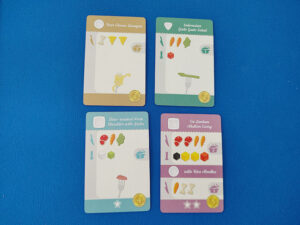
Since players work simultaneously there is no turn order, and the round structure depends entirely on how the team of players chooses to organize their actions. In general terms, however, players will need to seat patrons from the lobby and then take their order card, which will designate what type of ingredients need to be cooked to satisfy that customer. This ingredient list must be completed exactly as it is shown even down to the type of plate that the meal is served on. (But seriously: If customers are complaining about what plate you give them I think that’s more of a problem with the customer than it is the restaurant itself.)
Once players have taken orders, they can start to fill them by sending their sand timer employees to the stock rooms to gather ingredients. In the introductory levels, these ingredients are evenly spread across two stock rooms but as you get to the more advanced game certain ingredients will have to go to a separate location. Most customers also demand that their food be seasoned (the nerve!) and thus players will also have to add spices to the meals.
Finally, since this is a game about serving food, the meals need to be cooked to a certain level depending on what the item is. This action is done in the kitchen and players will slide their plates down their personal player board until the meal reaches the appropriate cooking time.
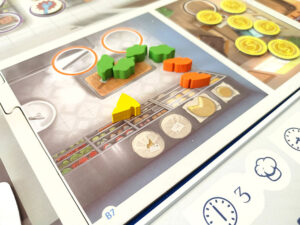
At the end of the timed round, which in most cases is four minutes, players will get paid for any meal they’ve finished correctly, but any errors they made along the way will force them to relinquish money or reputation, depending on the scenario and type of customer. (Friends are much more forgiving than the local food critic.)
The game includes a “ramp up” system involving eight increasingly difficult scenarios and a simple storyline to go with it. In effect this is a drawn-out tutorial as the early scenarios are so simple there’s no real reason to ever play them again unless you’re involving children or people who have never played a modern board game.
The game’s standard set-up is effectively the eighth scenario, which includes all the more complex elements of the game and also has the option to mix in various mission and event cards. This version of the game still has four-minute rounds—called shifts—but you play four of them consecutively. Players score at the end of each of these shifts in the form of money and reputation based on how well they served the more difficult customers in their restaurant. The goals for successfully winning the game usually involve hitting a target with some combination of money and reputation.
There are a lot of smaller rules like having to pay employees after each shift and the need to occasionally fix certain equipment in the kitchen (depending on which scenario and mission is in play) but this is the general idea of how Kitchen Rush works.
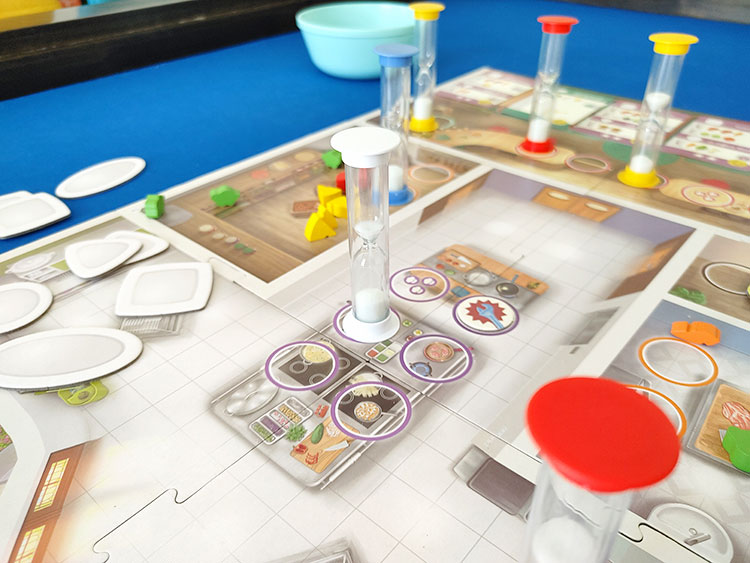
Game Experience:
Setting up the kitchen for the first time is neat as it’s a large puzzle of eight interconnecting pieces. The first few scenarios are intentionally simple, so while it was very easy to get a feel for how the timers work, as a seasoned cooperative board gamer I was concerned that the game was far too simplistic. (Seasoned… Get it?) By the fifth scenario, however, I could see how the chaos in the kitchen was increasing in a way that would prove more challenging while still being achievable.
Each new scenario also means you must change the layout of the restaurant by flipping over pieces of the puzzle, which is fun but I’m honestly not sure why anyone would ever go back to the “A side” of the restaurant once completing the beginning scenarios. It almost seems as though the sides of the board that are either blank or used as placeholders in the early scenarios could have just been blocked off in some way and made more complex as things progressed.
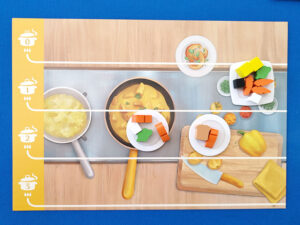
Still, the simple story the game tells about the restaurant’s improvement is pleasant enough and the scenario structure does make it easier to digest the collection of rules as you go along. (Digest… Get it?)
Scenario 8 is the set-up most people will utilize any time they pull this game off the shelf and it is a lot of fun to play with a fair bit of variability as well. No matter how well you come up with a strategy at the start of each shift, there’s inevitably going to be three or four times when someone knocks over their sand timer, which then causes three people to crash their hands into each other as they try to move their sand timer as well as the fallen one.
There will also be countless times when the only ingredient you need to finish a meal is a single slice of bread and the person to your left grabs it just before you can get there. You’re furious with that person and then you remember that you’re all actually working on the same team so them having that bread is good for you but now it means you’ll have to go shopping to replenish the bread and, really, who wants to go shopping?
The missions and events players can add also do a decent job of altering play styles for the remainder of the game. One mission, for example, removes a sand timer from every player until they take a specific action and spend some money. Similarly, the event cards impact the entire game by doing things such as limiting the number of plates available or making certain ingredients less abundant.
Final Thoughts:
My family and I are connoisseurs of the theme of this game. Not in the sense that we know anything about good food or how to make it, but rather because we watch a ton of cooking competition shows. As such, I expected to really like Kitchen Rush and for the most part, I did.
The first few scenarios were fun to play despite not really offering much of a challenge, so I was glad to get to the more difficult and involved scenarios. Once there, I found not only the more chaotic real-time aspects of the game entertaining, but also the way team strategy functions since players constantly have to communicate on where to send their people and when.
Even though the mission and event cards do change up some of the game’s conditions, I felt that the repetitive nature of the game hurts its overall replay value. Each game ends up being a very similar optimization puzzle with the same running timers. The goals will be different but the means to achieve the goals almost never are. Other real-time games (say Escape: The Curse of the Temple, for example) benefit from random elements within each game to both complicate the timer and vary the experience.
Kitchen Rush doesn’t really have any random elements during the game itself besides the orders players will take and all of those are filled in essentially the same way (grab ingredients, then cook them). It’s not the end of the world but this isn’t a game that will become a co-op you can go back to very often without it becoming stale. (Stale…Get it?)
Final Score: 3.5 Stars – With a great theme and friendly learning curve, Kitchen Rush is a wild and chaotic game that’ll be to fun to play from time to time.
 Hits:
Hits:
• Great theme
• Scenario structure helps introduce rules
• Mission cards break up the objectives
Misses:
• Early scenarios actually detract from replay value
• Every game tends to play the same way despite different objectives
Source: Board Game Quest





